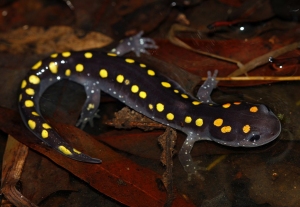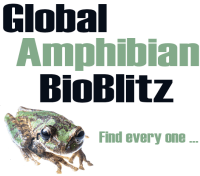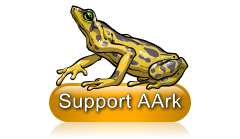In their efforts to conserve biodiversity, biologists and conservation practitioners are faced with the challenge of identifying and preserving the functionality of ecological and evolutionary processes needed to sustain populations and species in the face of global change and other threats. A very first step in any conservation plan, in or ex situ, should be to define the taxonomic unit to be conserved, to ensure adequate species knowledge. Often this unit will be a species, but in some cases establishing multiple, intraspecific management units will improve our ability to sustain viable populations and maintain the context for adaptation in the face of a changing environment. Delimiting such management units (often called evolutionary significant units, or ESUs) can be a challenging, yet critical part of successful management, especially for poorly known or highly variable taxa.

© Spotted Salamander, Peter Paplanus
Conservation management units (whether they be species or intraspecific units) are generally defined based on variation in one or more heritable traits (phenotypes). Historically, these traits were often morphological (e.g., size, shape, color), but more and more studies are considering genetic variation (e.g., mitochondrial DNA haplotypes or genotypes) as well. Both morphological and genetic phenotypes can be misleading. While one type of trait is not necessarily better or more informative than the other, considering variation in both morphological and genetic traits can be a particularly powerful way to reduce the risk of developing management plans that are inefficient, or worse, ineffective in conserving the taxon of interest.
What do we risk by considering only morphological variation? Populations that are genetically distinct, yet morphologically indistinguishable (cryptic variation) may go undetected if only morphological traits are considered. This could lead to management plans that either: (A) capture only a portion of the extant genetic variation (if management happens to focus on just one of the cryptic, genetic groups) and are therefore at increased risk for negative effects from inbreeding, or (B) suffer from problems with outbreeding or even the unintentional hybridization of cryptic species if genetically-distinct individuals are unknowingly bred with one another.
What do we risk by considering only genetic variation? Populations that are morphologically distinct, yet genetically similar (perhaps due to heritable polymorphism, or non-heritable variation) may be needlessly broken up into separate management units. If the lack of genetic variation suggests that gene flow is occurring, despite morphological differences among populations, establishing many morphologically-based management units could not only lead to unnecessary problems with inbreeding in each, but would likely waste valuable conservation resources as well.
When possible, the conservation practitioner should strive to first conduct or support phylogenetic and morphological analyses to determine which populations are distinct and require independent management. Examples of such analyses from the amphibian community include: ALLENOFT et al., 2009; BEAUCLERC et al., 2010; DALY et al. 2008; KRAAIJEVELD-SMIT et al., 2005; MORGAN et al., 2008; ZIPPEL et al., “2006”.
Research in 2012 by Crawford et al. used a DNA barcoding approach to survey mitochondrial DNA variation in captive populations of 10 species of Neotropical amphibians maintained in an ex situ assurance program, and found that three of ten species harbored substantial cryptic genetic diversity within the ex situ populations, and an additional three species harbored cryptic diversity among wild populations, but not in captivity. Ex situ conservation efforts focused on amphibians are therefore vulnerable to an incomplete taxonomy leading to misidentification among cryptic species. See DNA barcoding applied to ex situ tropical amphibian conservation programme reveals cryptic diversity in captive populations, for more information.
The next step is to convene experts with knowledge of the species (or other functional unit) in situ to identify the threats and requisite conservation actions. The AArk attempts to do this through Conservation Needs Assessment Workshops.
See the Establishing Ex Situ Amphibian Programs page for additional information on implementing amphibian conservation programs.
Literature cited
ALLENTOFT, M. E., SIEGISMUND, H. R., BRIGGS. L. & ANDERSEN, L. W., 2009. – Microsatellite analysis of the natterjack toad (Bufo calamita) in Denmark: populations are islands in a fragmented landscape. Conserv. Genet., 10: 15-28.
BEAUCLERC, K. B., JOHNSON, B. & WHITE, B. N., 2010. – Genetic rescue of an inbred captive population of the critically endangered Puerto Rican crested toad (Peltophryne lemur) by mixing lineages. Conserv. Genet., 11: 21-32.
Crawford, A. J., Cruz, C., Griffith, E., Ross, H., Ibáñez, R., Lips, K. R., Driskell, A. C., Bermingham, E. and Crump, P. (2012), DNA barcoding applied to ex situ tropical amphibian conservation programme reveals cryptic diversity in captive populations. Molecular Ecology Resources. doi: 10.1111/1755-0998.12054
DALY, G., JOHNSON, P., MALOLAKIS, G., HYATT, A. & PIETSCH, R., 2008. – Reintroduction of the Green and Golden Bell Frog Litoria aurea to Pambula on the south coast of New South Wales. Australian Zoologist, 34: 261-270.
KRAAIJEVELD-SMIT, F. J. L., BEEBEE, T. J. C., GRIFFITHS, R. A., MOORE, R. D. & SCHLEY, L., 2005. – Low gene flow but high genetic diversity in the threatened Mallorcan midwife toad Alytes muletensis. Molec. Ecol., 14: 3307-3315.
MORGAN, M. J., HUNTER, D., PIETSCH, R., OSBORNE, W. & KEOUGH, J. S., 2008. – Assessment of genetic diversity in the critically endangered Australian corroboree frogs, Pseudophryne corroboree and Pseudophryne pengilleyi, identifies four evolutionary significant units for conservation. Molec. Ecol., 17: 3448-3463.
ZIPPEL, K. C., IBÁÑEZ R. D., LINDQUIST E. D., RICHARDS C. L., JARAMILLO, C. A. & GRIFFITH, E. J., 2007 (“2006”). – Implicaciones en la conservación de las ranas doradas de Panamá, asociadas con su revisión taxonómica. Herpetotropicos, 3: 29-39.













